
That’s not to say, of course, that we don’t see our share of far-out concepts at the conference, or that every product comes to fruition. But what truly powers the show are sales of actual products. As much as we in media would like to consider ourselves a driving force of the event, the truth of the matter is we only make up a portion of the “industry representatives” in attendance.
The wrist continues to almost completely dominate the wearables conversation.
It’s for this reason that CES seems like the perfect platform for a sort of coming out party for wearables, as they finally make that long-awaited transformation from fledgling prototypes to a quantifiable — and dependable — consumer category. As someone who covers the space closely, I was certainly hoping to come away from the week with some manner of codified notion of where we’re at with all of this.
I didn’t.
Granted, the dust is still settling on all of the announcements as I write this, but I’d be lying if I told you I thought we were any closer to a big picture of what wearables are going to look like, moving ahead. This time last year, we were looking at a lot of companies with a lot of different ideas about what it would take to make a breakout wearable. The big difference in 2015 is … mainly the fact that there are even more companies involved in trying to crack this nut.
As predicted, Apple once again practiced its absentee magic, with the specter of the Apple Watch looming large over the proceedings. For better or worse, the sort of industry maturity we’re hoping is often catalyzed by the success of a single product that defines the space in terms of design language and base-level features. In so many instances over the past decade, that product just so happens to have a half-eaten fruit logo on it.

I’m sure I’m not alone in hoping that we’ll see things play out a little differently this time. It’s not due to any specific animus toward Cupertino (I’m typing this damn thing on a MacBook, after all), so much as it is a perpetual need to root for the little guy. At CES 2014, that scenario didn’t seem entirely out of the realm of possibility. After all, crowdfunded hardware startup Pebble managed to control the conversation with a flashy update to its original hardware.
This year, however, there was nary a peep out of the company, an absence that seemed to speak volumes in a show otherwise drowning in wearables. It was a vacuum, which, among other things, allowed big names to be the big names of the CES wearable parade — namely, Sony and LG.
In a sense, Sony pulled a Pebble, scoring big points with a beautiful upgrade to an existing product, namely the SmartWatch 3. It arrived at CES in a fancy new stainless steel suit, just like the Pebble Steel the year before. With the Apple Watch on the way, looks certainly matter more than they did in those earliest days, when wearing a smartwatch was a way to fly your geek flag on your wrist.
Surely next year, prettying up an existing product won’t be enough to truly garner interest.
Surely next year, prettying up an existing product won’t be enough to truly garner interest. But as the importance of style in space that’s meant to be worn on one’s person slowly dawns on CE companies, the mere act of making a nice looking product is still enough.
LG, meanwhile, made headlines by breaking from the pack with the W120L, a watch that runs a modified version of Palm’s abandoned but still much-beloved webOS. Perhaps it’s a sign of LG truly trying something new in this emerging space, rather than just staying on the Android bandwagon across product categories. Maybe it’s yet another symptom of the uncertainty surrounding wearables — after all, Android Wear is hardly a well-established presence at this point. Likely it’s some combination of the two.
Intel, naturally, showcased technology to restate its commitment to an emerging space — namely the button-sized Curie system-on-chip module. There’s only so much you can do at a show like CES when you’re essentially a components manufacturer powering future products, though the company did take the time to highlight its strange MICA (My Intelligent Communication Accessory) bracelet, another attempt to skip past the “nice-looking smartwatch” category straight into the luxury smart jewelry space.
OK, so maybe there is a codified theme in all of this — but it’s certainly no revelation. The wrist continues to almost completely dominate the wearables conversation. Sure, there were some relative wildcards like the Glagla Digitsole, which warms users’ feet in addition to tracking their steps, and the FITGuard mouthguard designed to detect head injuries early on. But at the moment the only larger trend they’re truly a part of is this nebulous category called “wearables.”
So, let’s take stock of where we are at the closing of CES 2015.
- Lots of companies really want to break into wearables.
- Everyone is sure that wearables are going to be huge, but there’s no cohesive narrative about how this will occur.
- Hey, maybe Apple will make this whole thing make more sense.
- We’ll start at the wrist and then work our way around the body from there.
I wish I could have walked away from this week declaring that CES 2015 was the year that the wearable category matured from “the next big thing” to a consumer standard, but that’s not the case. Still holding out some big hopes for 2016. See you in a year.


